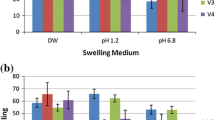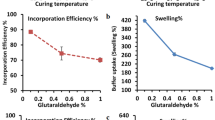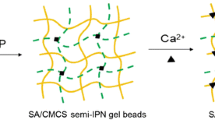Abstract
The aim of the present research work was to develop release modulated beads of losartan potassium complexed with anion exchange resin, Duolite AP143 (cholestyramine). Chitosan was selected as a hydrophilic polymer for the formation of beads which could sustain the release of the drug up to 12 h, along with drug resin complex (DRC). Chitosan beads were prepared using an in-liquid curing method by ionotropic cross-linking or interpolymer linkage with sodium tripolyphosphate (TPP). The formulation of the beads was optimized for entrapment efficiency and drug release using 32 full factorial design. The independent variables selected were DRC/chitosan and percent of TPP. The optimization model was validated for its performance characteristics. Studies revealed that as the concentration of chitosan and TPP was increased, entrapment efficiency and the drug release were found to increase and decrease, respectively. The swelling capacity of chitosan–TPP beads decreased with increasing concentration of TPP. The effect of chitosan concentration and percentage of TPP solution used for cross-linking on entrapment efficiency and drug release rate was extensively investigated. Optimized beads were subjected to in vivo studies in Wistar albino rats to determine the mean arterial blood pressure and compared with marketed formulation. The pharmacodynamic study demonstrates steady blood pressure control for optimized formulation as compared to fluctuated blood pressure for the marketed formulation.











Similar content being viewed by others
References
Johnston C. Angiotensin receptor antagonists: focus on losartan. Lancet. 1995;346:1403–7.
Ferrero C, Munoz RA, Jimenez CMR. Fronts movement as a useful tool for hydrophilic matrix release mechanism elucidation. Int J Pharm. 2000;202:21–8.
Hogan J. Hydroxypropyl methylcellulose sustained release technology. Drug Dev Ind Pharm. 1989;15:975–99.
Motycka S, Nairn JG. Influence of wax coatings on release rate of anions from ion exchange resin beads. J Pharm Sci. 1978;67:500–3.
Raghunathan Y, et al. Sustained-release drug delivery system I coated ion exchange resin system for phenylpropranolamine and other drugs. J Pharm Sci. 1981;370:9.
Jeong SH, Park K. Development of sustained release fast-disintegrating tablets using various polymer-coated ion-exchange resin complexes. Int J Pharm. 2008;353:195–204.
Kim CJ. Ion exchange resin drug delivery systems. Book, ion exchange resin drug delivery systems. Lancaster, PA: Technomic; 2000.
Sriwongjanya M, Bodmeier R. Effect of ion exchange resin on the drug release from matrix tablets. Eur J Pharm Biopharm. 1998;46:321–27.
Ilium L. Chitosan and its use as a pharmaceutical excipient. Pharm Res. 1998;15:1326–31.
Felt O, Buri P, Gurny R. Chitosan: a unique polysaccharide for drug delivery. Drug Dev Ind Pharm. 1998;24:979–93.
He P, Davis SS, Illum L. Chitosan microspheres prepared by spray drying. Int J Pharm. 1999;187:53–65.
Lim LY, Wan LSC, Thai PY. Chitosan microspheres prepared by emulsification and ionotropic gelation. Drug Dev Ind Pharm. 1997;23:981–5.
Mi FL, Wong TB, Shyu SS, Chang SF. Chitosan microspheres: modification of polymeric chem-physical properties of spray dried microspheres to control the release of antibiotic drug. J Appl Polm Sci. 1999;71:747–59.
Mi FL, Sung HW, Shyu SS, Su CC, Peng CK. Synthesis and characterization of biodegradable TPP/genepin crosslinked chitosan gel beads. Polymer. 2003;44:6521–30.
Ko JA, Park HJ, Hwang SJ, Park JB, Lee JS. Preparation and characterization of chitosan microparticles intended for controlled drug delivery. Int J Pharm. 2002;249:165–74.
Shu XZ, Zhu KJ. A novel approach to prepare tripolyphosphate/chitosan complex beads for controlled drug delivery. Int J Pharm. 2000;201:51–8.
Bodmeier R, Paeratakul O. Spherical agglomerates of water-insoluble drugs. J Pharm Sci. 1989;78:964–7.
Paulo C, Lobo JMS. Modeling and comparison of dissolution profiles. Eur J Pharm Sci. 2001;13:123–33.
Xu Y, Du Y. Effect of molecular structure of chitosan on protein delivery properties of chitosan nanoparticles. Int J Pharm. 2003;250:215–26.
Desai KGH, Park HJ. Preparation and characterization of drug-loaded chitosan–tripolyphosphate microspheres by spray drying. Drug Dev Res. 2005;64:114–28.
Nishioka Y, Kyotani S, Okamura M, Miyazaki M, Okazaki K, Ohnishi S, et al. Release characteristics of cisplatin chitosan microspheres and effect of containing chitin. Chem Pharm Bull. 1990;38:2871–3.
Author information
Authors and Affiliations
Corresponding author
Rights and permissions
About this article
Cite this article
Madgulkar, A., Bhalekar, M. & Swami, M. In Vitro and In Vivo Studies on Chitosan Beads of Losartan Duolite AP143 Complex, Optimized by Using Statistical Experimental Design. AAPS PharmSciTech 10, 743–751 (2009). https://doi.org/10.1208/s12249-009-9254-x
Received:
Accepted:
Published:
Issue Date:
DOI: https://doi.org/10.1208/s12249-009-9254-x




